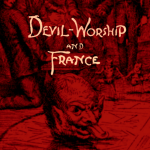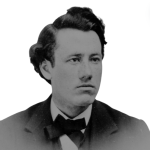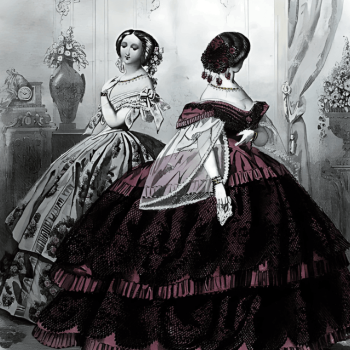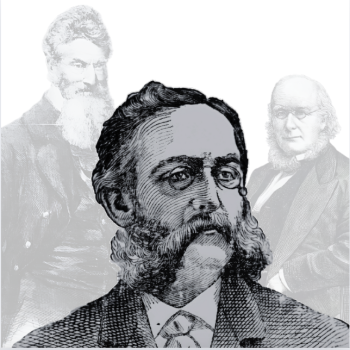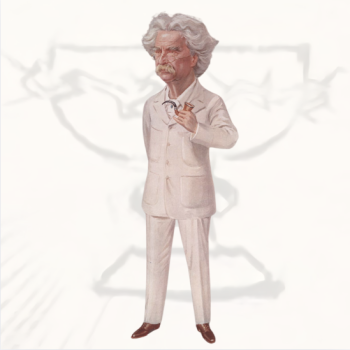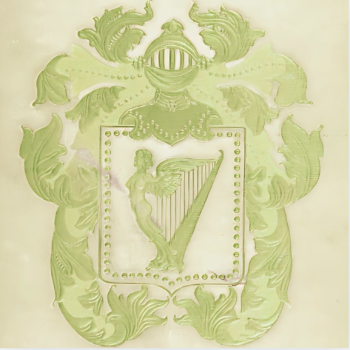HEATHER FROM THE GRAMPIAN HILLS
July 4, 1875.[1]
Colonel Henry Steel Olcott fastened the windows shut, and drew the blinds. The light from a single candle was all that illuminated the room. It cast an otherworldly effect on the seventeen people sitting around the bare mahogany extension-table in the back parlor of 12 Pembroke Street. Their thirty-eight year old host, the “Flower Goddess,” Mary B. Thayer, sat at the center of the table, her back facing the mantel. Her guests, twelve women and four men, waited expectantly. Olcott locked the doors of the room, placed the keys securely in his pocket, and took his seat to the left of Thayer. The candle was then extinguished.
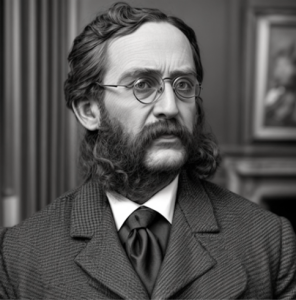
Colonel Henry Steel Olcott.
The Fourth of July celebration of 1875 was displaced in Boston. Having landed on a Sunday it would instead be celebrated on the following day.[2] The séance at Thayer’s residence, however, defied convention, and commenced as planned on the Sabbath. Olcott placed his hands upon Thayer’s hands, and his foot upon her two feet. This was done to further eliminate the possibility of fraud.
The participants then began to sing. (This had become something of a tradition in nearly all spiritual circles. At times the music was so horrendous that Thayer expressed an open conviction that the living would scare away any spirit within twenty miles of Pembroke Street. Her hint was noted, and volume and tone were adjusted.
William Lloyd Garrison had seen evidences of Thayer’s rare powers under test conditions, and had full confidence in her good faith. The strongest evidence that Thayer could present to Olcott’s scrutiny, however, was her own pretty face. (In all his investigations of spiritual mediums, he was careful to inquire as to the heredity of the psychic power.) It was an open, frank, face. It was a face marked with lines of care that showed signs weariness; this indicated passivity over force, of amiability over aggressiveness. Her oval head was of moderate size, well-arched in the crown, and symmetrical. Her hair was a dark chestnut; eyes of blue, and complexion fair. Her mouth was delicate, and had a straight nose. She stood five-feet six-inches, and, with increasing years, and sedentary life, had grown stout enough to turn the scale at 160 pounds. Her voice was soft, not guttural like many of the modern pythonesses, and her manners were free from embarrassment or affectation. She must have been a beauty once, Olcott thought.
Thayer was born Mary Smith in Concord, Maine, of rustic parentage. Her mother, also a seeress and medium, had countless premonitions. Sometimes there was a heavy knocking at the door, but no one was there when they answered; sometimes the tread of invisible feet could be heard over head. Her mother saw the spirits of dead relatives stalking through the walls, partitions, and closed doors, of the house, and would talk to them in such a way that would make a one’s blood curdle. Like Thayer, her mother had flowers brought to her by the invisible powers. One day in midwinter, when Thayer was ten years old, she and her two brothers were about to start for school when the mother came out of the house, weeping, and holding in her hand a freshly plucked rose. She said that is was brought to her from heaven, and was a warning of the death of one of her children. The farm was the heart of the Maine wood, the snow lay thick upon the ground, and there was not a flower pot in the house, nor a greenhouse within many miles. The children saw nothing ominous in the fragrant flower, rather they thanked the angels for bringing them something so pretty. But the omen of the rose was true, and the youngest brother died before spring of malignant fever. Just before he died there came a crash against the side of the house, as though some phantom spades-man had thrown a shovelful of gravel with all his force.
The children soon began to have their own mystical experiences. Mischievous elfin children would visit them every day to play with them for hours at a time. The children had heard the old people talk about witches, and so, for lack of a better name, called their spirit playmates “the witches,” and were careful not to offend them, and keep in their favor by leaving bits of their candy and cake for them to eat. The phenomena became gradually more insignificant in character, until 1853, when she married Anson Howard Thayer of South Braintree.[3] When her first child was three weeks old, the bed on which she slept was lifted off the floor, and then gently settled down again. She then began experiencing the same portents as her mother, knowing by mystic signs of impending deaths and calamities. Before Anson’s death in February 1857, she saw a bright light shine in her room with her husband’s face in its center.[4] A widow with two children to support, took to dressmaking to make some money.
The year that Anson died, Spiritualism had come under attack in nearby Cambridge. A student named Frederick Willis was expelled from Harvard Divinity School for acting as a Spirit-Medium. “The Faculty of Harvard University pronounced the opinion that ‘any connection with spiritualistic circles, so called, corrupts the morals, and degrades the intellect,’” Olcott would say, “they even had the effrontery to say that they deemed it ‘their solemn duty to warn the community against this contaminating influence, which surely tends to lessen the truth of man, and the purity of woman.’”[5] Yet, a book published in 1874 made the claim that Louis Agassiz, Harvard’s esteemed zoologist was appointed to the committee to investigate Willis’s claims, actually had Spiritualist sympathies, thus revising the whole affair for a new generation.[6]
In 1865 Thayer was forewarned that she would pass through a dangerous sickness, during which “something very wonderful in the way of mediumship” would come to her. The prophecy came true in 1872, when she suffered from a near-fatal case of gastric fever. In her hallucinogenic ravings, Thayer turned prophetess. She eerily announced the Great Boston Fire of 1872 during a visit to her physician down to the very minute. When she recovered, she went to live as a housekeeper in the home of Madame Barker, an old woman who kept a dancing school in the Deacon House.
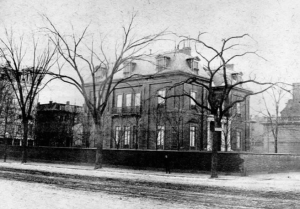
Deacon House c. 1871.[7]
The great, rambling structure, completed in 1848, occupied a whole square of ground at Washington, Concord, and Worcester Streets. It held the distinction of being the first building in America to have a “French” (mansard) roof. It was commissioned by Edward Preble Deacon, a handsome young man “ without visible property,” who married Sarah Annabella, the daughter of Peter Parker, an affluent merchant who lived at 49 Beacon Street.[8] With his father-in-law financing the project, Deacon made several trips to Europe to purchase art for Boston’s most opulent home. “The fine house did not bring good luck,” as Olcott would say. Deacon died of consumption in 1851, while Sarah Annabella became a recluse in Paris. Deacon House was shut up for at least a decade, becoming meanwhile, “the roosting place of a trooper of ghosts, who made its empty rooms ring with noises calculated to send the belated by-passer in panic to the other side of the street.” It got such a bad name, that when it was put on the market, no tenant could be found who would rent it. That is, no one until the valiant Madame Barker. She installed herself, and received Thayer as housekeeper in due course.
The hauntings became ten times worse. Spirits would open locked and bolted doors, only to slam them again. They carried articles along corridors, from one locked room to another. The dead Edward Deacon, and other “uncanny prowlers” would even show themselves on occasion. But the women “stood it like veterans,” and soon Thayer’s new mediumship showed itself. It was at this time that Thayer met Dora Brigham, the eldest daughter of Rev. Edward Taylor, or “Father Taylor” as he was known, the famous sailor missionary.[9] One of the earliest members of the Anti-Slavery Society, Dora’s home was one of the stations in of the Underground Railroad, and would herself earn the moniker of “Mother Taylor.”[10] Brigham and Thayer’s other friends would drop in, and they improvised “circles” around a table where they would manifest all sorts of startling psychic phenomenon, such as tabled floating in the air, or the lifting Thayer (chair and all,) onto the table, the bringing of coats and hats from the hall tree into the room.[11]
Those manifestations, Olcott believed, were less to be accredited Thayer’s mediumship than the “surcharged atmosphere of this haunted house.” Thayer’s mediumship was far more attractive; the spirits brought her butterflies, flowers, fruits, and birds, of all sorts, and all kinds. It began at sitting one evening when a visiting gentleman read an account from an English Journal of the flower phenomena of London medium, Elizabeth Nicholl Guppy. The visitor remarked how pleasant it would be if they, too, could have flowers brought to them. They agreed to try and see if the spirits would not gratify their request. The gas was turned off, and they smelled the perfume of a flower. They lit the gas, and there laid a full-blown tuberose. The auspicious beginning was followed up with natural assiduity. The casual visitor would regularly install themselves as a member of the impromptu circle.[12]
Soon after the séance commenced, Olcott could sense that Thayer was growing distressed. She began to convulse as though great gushes of electricity were passing through her frame. Her whole system seemed transfigured in painful labor. Her breathing became irregular, as Olcott felt her hands grow cold.
In this scene of profound darkness, the sound of swishing of leaves was heard. This was followed by a dull thump—as if a pile of earth had been dropped from the ceiling onto the table. Then a sweet fragrance filled the room, and a flower, “cool to the touch,” fell upon Olcott’s hand. He was not the only one to experience this. All around the table people were murmuring with excitement that something had fallen on them, or been thrust into their hands. This foreplay of mystery was unbearable.
“Light!” someone demanded.
The single candle, re-commissioned, revealed a sight of charming, though mysterious, whimsy. The table was completely covered with fresh plants and flowers, all sparkling with dewdrops. Among the floral banquet spread before them were calia lilies, sprays of fern, palm leaves, bonne celine roses, blush roses, crimson roses, heliotropes, pansies, a shrub of ghost-berries, and patches of growing moss.
“This is a perfect test for me!” one woman declared, while admiring the wax begonia in front of her. “My spirit-sister told me yesterday that if I should come here, I would receive this plant as a present from her!” she explained.
One man seemed transfixed by a full-grown heather plant before him. It was in bloom, a vibrant mauve with dirt on the roots. So fresh was the plant, that worms still wriggled amid its roots. Considering the bulk that such a collection would make, and the fact that the flowers were fresh, un-crumpled, and the petals covered with dew, it appeared to be conclusive that neither Thayer, nor any possible confederate, had brought them into the room by trickery.
After the séance Olcott approached the man who had been transfixed by heather. He was a Scottish Civil Engineer named Horace McMurtie, who once traveled with David Livingstone. A sober-minded man, in 1866 he married Louisa Goddard Gould, sister of the eminent American astronomer Benjamin Apthorp Gould.[13] McMurtie, like Olcott, was conducting an investigation into various spiritual phenomena.
“Recently, during a private séance with another Boston Medium,” said McMurtie, “I received direct communication from the spirit of a dead relative in Scotland who told me that if I were to attend Mrs. Thayer’s Circle, I would be rewarded with living heather from the Scottish Highlands.” McMurtie paused for a moment. Olcott’s face was handsome, pleasant, and instilled in the minds of his peers that he was a confident, and honest man. However, Olcott had an ocular quirk that revealed itself when he was excited, and only somewhat concealed by his spectacles. One of his eyes was extremely disobedient, and would, on occasion, wander off on its own. When his “disobedient eye” remained stationary, everything was calm, but when irritated, and something twitched, the rogue eye strayed knavishly, and the confidence of his face diminished.[14] “I told no one of this,” McMurtie continued, “and yet, just as the spirit promised, the mountain-heather appeared.”
While the others mingled, Olcott took inventory of the plants, cataloguing over eighty entries. He noticed something strange about the already very strange phenomenon. The stalks appeared to have been broken off, and around the fibrous fracture, in nearly every case, there appeared a little black ring, as though an electrical current had effected some chemical action in the chlorophyl.[15]
ANTIQUES AND HORRIBLES
July 5, 1875
Though Monday was not generally kept with any extensive demonstrations of patriotism, the “Antiques and Horribles,” paraded through town in the in the early morning, which excited considerable amusement by their “grotesque devices.” The parade was a folk tradition reinvented. The “antiques” were those burlesquing in the moth-eaten finery of Massachusetts governor’s honor guard, with some uniforms dating as far back as 1776. In contrast, the “horribles” were those who donned elaborate costumes, masks, cross-dressing, and blackface in gender and class reversal. The satire being aimed primarily at authority, women, and foreigners.[16] The popular costumes that year included the preacher, Henry Ward Beecher (still shamed in the press for his extramarital affair the year earlier,) characters from Shakespeare’s plays, the “King of Cannibal Islands” (with several members of the “nobility,”) and “woman suffragists,” (incontestably proving the “superiority of the feminine intellect to that tyrant of a man.”) There was also no shortage of “Black Hills miners.”[17] In the decade after the Civil War, the financial interests of Boston was focused on the railroad developments beyond the Mississippi. The image of the American West, had changed from one of backwardness to one of promise, particularly the Arizona Territory. The Rev. Edward Everett Hale, “dean of literary Boston,” was among those who championed further scholarship on the region.[18]
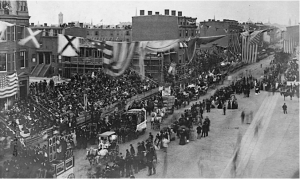
Bunker Hill Day Parade. June 17, 1875.
The band concert in Boston Common drew a large audience, while Rev. James Freeman Clarke’s oration in the Masits Hall, occupied the attention of the more serious citizens. The rowing regatta on the Charles River attracted a large number of people, and those who went down the harbor to view the yacht regatta were repaid by a splendid sight and the cool breath of the Atlantic. The children had their customary entertainments in the various halls of the city, and all the theatres gave matinee performances. The general desire of Bostonians on the Fifth of July, however, was that of a retreat to sylvan shades in the country, or a quiet day at home. Olcott, did not need to travel far, being already in the suburb of West Roxbury, staying as the guest in the elegant home of the well-known lawyer, Charles Houghton, and his wife, Edna.[19]
Public sentiment seemed to indicate that with the opening of America’s second century, a different spirit would gradually animate the nation’s Fourth of July observances, with the future forming by degrees a larger topic of contemplation than in years past. The last such observation before the Centennial, it was a eulogy to the old order, and optimistic greeting to the new spirit of the age. The sentiment of independence was now freighted with the sense of self-government, extending into all aspects of National existence. It was not just battles and final victory that was revived in the thought, for the air was filled with the voices of peace, reunion, and fraternity, from those who survived the battle-grounds themselves. It was Washington’s words, rather than his sword, that shined in 1875, bidding Americans to maintain a jealous-watchfulness against the inroad of mutual distrust, sectional feelings, and alienation. The associations of force, of resistance, of struggle gave place to new-born hopes of restored brotherhood and universal amity.[20] The rain in the evening precluded any extensive pyrotechnic display, making it exceptionably free from the noise of fire-crackers, torpedoes, and fish-horns. Indeed, the Fifth of July was celebrated in a quiet, almost sedate manner in the environs of Boston.
A month shy of his forty-third birthday, Olcott reflected over the Nation he served, his life in general, and previous year in particular, as the gentle summer rain tapped the earth. Born in Orange, New Jersey, he was the seventh generation of “Puritan stock,” his parents being Thomas Olcott, and Emily Steel. The family would grow in the coming years with addition of Belle, Anna, Emily, Emmett, and George, and move across the Hudson to New York City. He enrolled in New York University when he was fifteen, but financial strain compelled him to drop out. He left home for Ohio in 1848 to try his hand in share-farming.
Olcott was then drawn to Mesmerism, a theory which developed in the late eighteenth-century that postulated that there was an unseen “magnetic fluid” that bound creation, and which could be manipulated by practitioners with the proper training. (Olcott would experiment, with varying degrees of success, in Mesmeric healing throughout his life.) Mesmerism would gain a following, but was later absorbed into the uncodified babel of heterodox spiritualities of America. Olcott would also delve into the greatest of those emergent spiritualities, a successor, in some ways, to the Shakers. The year that Olcott moved to Ohio, marked the beginning of Spiritualism; it was then when the Fox sisters heard the rappings and tappings of spirits in their home in Rochester, New York. The sophistication of the movement would develop accordingly in the subsequent decades, especially after the Civil War, when everyone was haunted. Some were haunted by ghosts, some were haunted with memories, but everyone was haunted.
After some time spent Ohio, Olcott found himself in Newark, New Jersey, where he learned the latest advances in agricultural science at the model farm of Professor J.J. Mapes. It was here that Olcott got his first taste for journalism, editing Mapes’s magazine, The Working Farmer. He would also publish two books, Sorgho And Imphee, The Chinese and African Sugar Canes (1857,) and Yale Agricultural Lectures (1858.) When the model school closed down, Olcott went to New York, to live with his sister Bella in their family home. It was not long before he found work as the Associate Agricultural Editor of The New York Tribune. It was in the capacity of a journalist through that organ, that Olcott traveled to Virginia to witness the ”first act in the bloody drama of the American Conflict,” the hanging of the abolitionist, John Brown. Olcott would never forget how Brown’s eyes lingered wistfully upon the few civilians who were permitted to gaze from a distance upon his neck in a noose. It seemed to Olcott, that Brown longed for the glimpse of one friendly face.[21]
Upon his return to New York, Olcott married Mary Eplee Morgan, the daughter of a Rector of an Episcopal Church. They had their first child in 1861, a boy they named Richard Morgan after Mary’s father. Four months later the American Civil War began. Olcott volunteered for duty, and served under General Ambrose Burnside (the namesake of the species of beard which Olcott wore.) During the Annapolis campaign, a personal scrimmage with malaria removed Olcott from the field of battle. Olcott was then made Special Commissioner of the War Department, and tasked with investigating Soloman Kohnstamm, a suspected racketeer. Leading a team of detectives and stenographers, Olcott found fraudulent dealings, and saved the Federal Government a substantial sum.[22] He was promoted to the rank of Colonel by a grateful war department. The Secretary of War, Edwin Stanton, wrote a letter to Olcott, praising his contribution as being “as important to the Government as winning of a battle.”
On his thirty-second birthday, one of Olcott’s sons died, Henry Steel Olcott, Jr.[23] This tragedy was followed by the assassination of President Abraham Lincoln in April 1875, just days after the end of the Civil War. Edwin Stanton recruited Olcott to lead a three-man team to hunt down the culprits of the conspiracy. His investigation helped lead to the capture of John Wilkes Booth.
At the end of 1865, Olcott resigned from the Commission, and returned to civilian life. He spent two years working in a law office, eventually passing the New York Bar in 1868. He supplemented this career by working as an occasional reporter for the New York newspapers. While traveling to London in 1870, Olcott learned of the death of his infant daughter, Bessie.[24] It was then when his interest in Spiritualism was rekindled.[25] While in London Olcott first met his spirit-guide, “John King.”[26] When he returned to New York, he was retained as Attorney for the City Treasury for “certain large suits,” by District Attorney E. Delafield Smith, whom Olcott had previously worked with during the Kohnstamm trial.[27] Olcott, however, had become a broken man, complete with a failing marriage. “The sweetness of common life had all gone out from me,” Olcott would say, “I was neither hungry for fame, nor money, nor love.”[28]
“NO MAN’S LAND”
July 6, 1875
On July 6, 1875, Thayer arrived at the Houghton residence, where a private séance was conducted for the benefit of Olcott, Charles, and Edna. Thayer was to remain with them for a few days so that Olcott could better detect fraud or collusion for his investigation. The Houghtons had both previously attended several séances by Thayer in the preceding weeks, so they were well-acquainted.[29]
The sitting began in the library, but conditions were more suitable in the adjoining room. The gas was extinguished, and all four joined hands. They waited a long time, but no phenomenon occurred.
“Just when it was most essential for my reputation that something should come,” Thayer lamented. She was frustrated, disappointed, and on the brink of tears. “I am powerless.”
Olcott shared no such feeling. On the contrary, to his mind the best proof of genuine Mediumship was “often the failure of the phenomena to appear at the very time when the Medium most desires them,” reasoning that “tricksters suffer no such misfortunes.”
Just when they were ready to abandon the experiment, there came the familiar patter upon the table, and the fragrant odor of flowers. When the gas was lit, an assortment of roses varying in shape and kind, were in full display. The gas was again extinguished, and again there came a sound, louder than the first. Once more the gas was lit. This time the party saw the long stalk of the annunciation lily.
“Why,” said Edna, “this is one of my own plants from the garden.” Edna examined it closer. “This is the only flower, though, that could have come from our residence,” Edna explained, “for the worms have destroyed our rose bush.”[30]
The following evening a select party of twenty ladies and gentlemen sat with Thayer around the table in the Houghton’s dining room. One guest being Mary Dana Shindler, a Southerner, who traveled from the interior of Texas that Spring to investigate the “consoling fact of spirit communion.”
It was very warm, and Thayer complained of feeling very unwell and quite exhausted. She feared that the séance would be a failure. Nevertheless, the room was thoroughly searched, the doors were secured, hands were locked, the gas extinguished, and the usual singing began.
Soon the familiar sounds of something falling upon the table were heard.
“Light!”
There were a few flowers; enough to give one specimen to each person present. A large green leaf of the Calla lily, wet with dew, was Shindler’s share of the floral offering.
The light was again extinguished. This time the spirits were rather more liberal.
When the light was struck, a larger supply of flowers was discovered. One man received an English Ivy, about three feet long with a quantity of dirt adhering to its roots.[31]
The gas was extinguished again. This was when the rappings and poundings began. This continued for some time, reaching a climax with the sound of a sharp crash upon the mahogany.
This induced the Houghtons to light the chandelier at once. There before them were two stones, each half as large a person’s fist. There was also a common iron-bladed table knife of a quaint shape. The point of the blade was half as wide as the rest, with a semi-circular protuberance that was made at the back. It looked as though it were intended for a person to eat his food, peas, and all, mostly with the knife.
The guests consulted Olcott’s spirit guide, “John King,” who informed them that he had brought the curious implement from “No Man’s Land.” He set aside the utensil in a safe place to further examine the next day, but when he awoke, he discovered that it had mysteriously vanished.
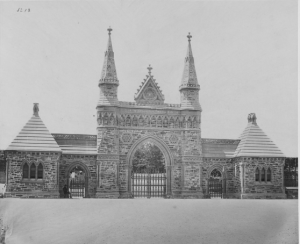
Gateway, Forest Hills Cemetery c. 1870.[32]
In the afternoon, during the course of a drive, Olcott paid a visit to Forest Hills Cemetery. Passing through the green houses his attention was struck by a Dracaena Regina, a curious plant with long, narrow leaves, and striped with white and pale green. With his blue pencil, Olcott marked a cabalistic sign of the interlaced triangles, commonly called “Solomon’s Seal,” on one of the leaves. He then asked the spirits to bring it to him at the circle on the following evening. He purposefully sat on the right side of Thayer’ and held her hands, when suddenly he felt something cool and moist fall onto his hand. When the candle was lit, he found it to be his marked leaf. He went to the greenhouse again, and found that the leaf selected by me had actually been broken off.[33]
DARK AND STORMY NIGHTS
It was a dark and stormy night. Olcott was alone with Thayer, giving her a reading from Edward Bulwer Lytton’s novel, Zanoni. Thayer had winsome manners, and cheerfully sat on the steps of the Houghton’s staircase listening to Olcott’s recitation.[34]
“‘The cloud retreated from it as it advanced,’” Olcott began, gesticulating his arms for dramatic effect. “‘The bright lamps grew wan, and flickered restlessly as at the breath of its presence. Its form was veiled as the face, but the outline was that of a female; yet it moved not as move even the ghosts that simulate the living. It seemed rather to crawl as some vast misshapen reptile; and pausing, at length it cowered beside the table which held the mystic volume, and again fixed its eyes through the filmy veil on the rash invoker. All fancies the most grotesque, of Monk or Painter in the early North, would have failed to give to the visage of imp or fiend that aspect of deadly malignity which spoke to the shuddering nature in those eyes alone. All else so dark—shrouded—veiled and larva-like. But that burning glare so intense, so livid, yet so living, had in it something that was almost human in its passion of hate and mockery—something that served to show that the shadowy Horror was not all a spirit, but partook of matter enough at least to make it more deadly and fearful an enemy to material forms.’”[35]
Olcott paused to gauge the Thayer’s response. The bright light from the chandelier softened the dread of that vivid passage, but steady white noise of rain outside acted as a counterbalance. A procession of severe thunder storms had marched through Boston all week, causing considerable loss of life. As was the case in New York a year earlier, these storms were accompanied by strange balls of lightning.[36]
“Where was I?” said Olcott, resuming the reading. “‘As clinging with the grasp of agony to the wall—his hair erect his eyeballs starting, he still gazed back upon that appalling gaze—the Image spoke to him—his soul rather than his ear comprehended the words it said: Thou hast entered the immeasurable region. I am the Dweller of the Threshold. What wouldst thou with me? Silent? Dost thou fear me? Am I not thy beloved? Is it not for me that thou hast rendered up the delights of thy race? Wouldst thou be wise? Mine is the wisdom of the countless ages. Kiss me, my mortal lover.’ And the Horror crawled near and nearer; to him it crept to his side its breath breathed upon his cheek—’”
Olcott’s reading was interrupted by a gasp from Thayer, whose face was now deathly pale. Her eyes closed; she raised her two hands as if to grasp something over his head, and at the instant, a young canary sprang forth from Olcott’s head. It flew, disoriented, and frightened, toward a closed door. Olcott looked at Thayer to make sure his eyes had not deceived him, then cautiously cornered the little bird, and cusped it in his hands. It looked like Madame Blavatsky’s bird, Jenny.[37]
It was nearly a year to the day, July 11, 1874, to be exact, when Olcott sat in his law office at Nassau Street, thinking of a heavy case related to the mechanical construction of water meters.[38] His mind began to drift, so he thought it best to leave his office and clear his thoughts.
He was then living at 2 Irving Place in New York, in an unfurnished room in the top floors of the Lotos Club headquarters. [39] He had become a man of clubs, drinking parties, and mistresses. That is to say, he became a man absorbed in worldly distractions.[40] The Lotos Club was a comparatively new organization, which sought to promote “social intercourse among journalists, literary men, artists and members of the musical and dramatic professions, and such merchants and professional gentlemen of artistic tastes and inclinations.” It sought to capture the “sense of rest and harmony,” found Tennyson’s poem, The Lotos Eaters, which enjoyed widespread popularity at the time.[41] Being only a decade after the end of the war, many of the club-members, like Olcott, had witnessed enough conflict. It was during this time that Olcott met Mark Twain who stayed at the Lotos Club that summer. He was in New York debuting his new play “The Gilded Age,” on the East Coast. (Both men were commissioned to write a piece for the club’s upcoming book, Lotos Leaves.)[42]
It had been an eventful summer to say the least. In June Olcott met Kevasji Merwanji Shroff, a graduate of Elphinstone College, a well-known Parsi citizen and Corporator of Bombay.[43] Shroff was visiting New York in connection with his study of the American education system. While there, he would lecture about the Parsi religion in the leading American universities and clubs. It was in this capacity that Shroff participated in the commencement exercises of the University of the City of New York, where he shared the platform with Olcott’s friend and colleague, Edward Delafield Smith.[44]
Other events were not so auspicious. News of Henry Ward Beecher’s affair were well-ventilated in the press. The scandal was certainly corrosive to claims of moral authority of the sacerdotal class, but science, too, had its share of setbacks.[45] Then there were reports from Custer’s Expedition in the Black Hills, which told of mysterious caves, and hinted at lost antediluvian civilizations.[46] Then there reports of the devastation caused by a massive plague of locusts out West.[47] Things were not less quiet back in New York, far from it. Coggia’s comet blazed across the night sky, and with it the resurgence of old superstitions—much to the dismay of “modern science.”[48] There was the rabies outbreak that plagued the city. One of the mad dog was even killed by Officer Shea, of the Second precinct, at the corner of Nassau and Ann Street near Olcott’s Law Office.[49] Like the reaction to the comet, theories about the disease, and the “mad dogs” that carried it, forced scientists to compete with the popular opinion that there was “some occult connection between the ascendency of the star Sirius in the heavens, and the ravages of hydrophobia on earth.”[50] Eerier still were the mysterious balls of lightning, which arrived in swirling black clouds which reeked of sulfur. Reports stated the “freak lighting,” entered people’s homes in peculiar ways, and was even blamed for the destruction of the oil tanks in Weehawken, New Jersey.[51]
Olcott walked down Beekman Street to the corner stationer to purchase a copy of The Banner of Light (a Boston Spiritualist magazine,) “desiring to read something concerning the Katie King mystery.”[52] (A spiritual manifestation allegedly conjured by the Philadelphia Spiritualists, Nelson, and Jennie Holmes.) The horizon was so overcast with thick masses of dark clouds, that the colossal twin piers of the quickly-rising Brooklyn Bridge were barely visible.[53] When evening arrived, Olcott sat in his office, distracting himself with his magazine. Flashes of lightning and distant peals of thunder filled the sky, and rain poured down in cataracts, rushing and flooding the streets. Olcott found himself transfixed with an article called “Seance With The Eddy Mediums,” about the Mediums, Horatio, and William Eddy.[54]
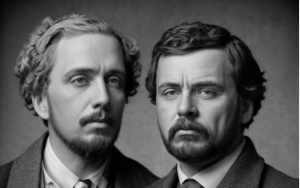
Horatio & William Eddy.[55]
Olcott decided that he would investigate the Eddy farm himself, and write a piece about it for a New York newspaper.[56] Before leaving New York City, Olcott thought it well to ascertain the views of Andrew Jackson Davis whom he found in his cozy bookstore, at 21 East Fourth street.”[57] Davis was the father of American Spiritualism, who introduced the concept of the “Laws of Attraction.” His works were greatly influence by his predecessors, Emmanuel Swedenborg, and Franz Mesmer. The notion of a natural energy, or “magnetic fluid,” which transferred through all matter (animate and inanimate alike) was articulated in Mesmer’s theory of “animal magnetism.”[58]
Olcott arrived at the Eddy farm on August 28, 1874. His reception was “in the highest degree unsatisfactory.” They initially refused him admittance, but he clung to them with such pertinacity that they finally made room for him.[59] After witnessing the séances, Olcott returned to New York where he published his account, “The World of Spirits,” in the September 5, 1874, issue of The Sun. Olcott returned to the Eddy farm that Autumn to conduct a more thorough investigation that would eventually culminate in his 1875 book, The People From The Other World. It was then when he met the mysterious Russian woman, Madame Helena Petrovna Blavatsky. She had somewhat “ample proportions,” with a large head that was covered with crinkly rust-colored hair. Her eyes were icy blue, but her gaze was warm, some would even say, mystical. Her delicate hands, which betrayed her aristocratic lineage, were adorned with rings of curious design.[60] She had read Olcott’s account, befriended Andrew Jackson Davis, and traveled to the Eddy farm specifically to meet Olcott.[61] She arrived in New York City on July 7, 1873, where she lived for some time at 222 Madison Street.[62] She purchased some land in Long Island, and tried her hand at farming, but that was an enterprise she was only too happy to abandon.
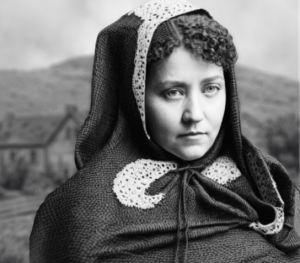
Helena Petrovna Blavatsky.
They were soon joined at Eddy Farm by the Spiritualist, Dr. James M. Peebles, who had just returned to America from Ceylon where he witnessed a great debate between Buddhist orators and Christian Missionaries known as the “Panaduraa Waadaya.”[63] Blavatsky and Peebles were already somewhat acquainted with one another. When Blavatsky lived in Cairo, Egypt, in the early 1870s, she operated a Spiritualist Society known as the Société Spirite. When Dr. Peebles last toured Asia, he paid a visit to Cairo where he called on Blavatsky at her rooms in the Oriental Hotel.[64] Blavatsky demonstrated her own powers at the Eddy farm, summoning the spirit of Bessie, Olcott’s daughter, who died just before her second birthday.[65] The child reached out her hand to caress his face, providing a degree of closure to Olcott.[66]
Blavatsky returned to New York where she took a room at 16 Irving Place.[67] When Olcott returned from the Eddy farm, he became a frequent visitor, and they became close friends. Blavatsky then went for a brief visit to friends in the country. When she returned, she took up residence in at 23 Irving Place, near the Lotos Club, and maintained regular correspondence with Alexander Aksakov, Counsellor of State in the Imperial Chancellery. The creator of the term “telekinesis,” Aksakov had conducted successful séances with his colleague, Nikolai Wagner, and Alexander Butlerov. This lead to the establishment of the Society of Experimentalists in the Physical Sciences within the Imperial University of St. Petersburg. In November 1874, Blavatsky moved to Philadelphia, where she lived at 1111 Girard Street. Here she investigated the séances of Nelson and Jennie Holmes. (It was also where she bought her little canary, “Jennie.”) Olcott would join her for some time. Blavatsky slowly divulged that she was an agent of the Masters, a secret, and ancient Lodge of semi-divine beings. She disclosed that her Lodge sent her to America to investigate modern Spiritualism, to “unveil what is, and expose what is not.”[68] For reasons known only to herself, Blavatsky also married a Georgian man, a brief footnote named Michael C. Betanelly, but this was never consummated. She then injured her leg. It was eventually cured by “John King,” but a residue of pain lingered owing to lack of rest. During this period Olcott tried, unsuccessfully, to launch an organization known as the “Miracle Club.”[69]
In the Spring of 1875, Aksakov invited famous mediums of various countries to present themselves before a commission in St. Petersburg to display their alleged psychical phenomena, under test conditions. He asked Olcott to act, in conjunction with Blavatsky, to be his American representatives in finding suitable mediums in the United States. That was the purpose of his visit to Thayer in Boston. [70] Blavatsky would soon join him.
THE ROSE
Late July 1875.
By the summer of 1875, the writings of Blavatsky and Olcott had evolved in character and substance. Blavatsky’s “first occult shot” against Spiritualism was fired shortly before arriving at the Houghton residence. In an article titled “A Few Questions to ‘Hiraf,’” in The Spiritual Scientist, Blavatsky stated: “We believe that the time is near at hand when our sham Spiritualism will be purged of its dross, and the true significance and beauty of this faith will stand revealed.”[71]
A practical demonstration would soon follow. Olcott and Edna took a carriage to Pembroke Street to attend Thayer’s evening séance. Blavatsky stayed behind in Roxbury to talk with Charles in the drawing-room. The séance proved shorter than expected. Olcott, Edna, and one other woman remained after everyone else had left, and were granted a private sitting.
Olcott held Thayer’s two hands, and placed a foot upon her two feet. Edna fastened the doors and saw that the windows were secure, the other woman took charge of the light. They waited in darkness for some time but there was no sound of plant dropping. Just as the carriage was heard approaching outside, Olcott felt a cool, wet, flower, as delicate as a snow flake, fall on the back of his hand. He said nothing to the ladies until the candle was re-lit. The flower on his hand was a dewy, half-opened rose bud. Accustomed, now, to the floral demonstrations of Thayer, Olcott was more impressed than astonished. It was the events which followed that truly startled him, beginning with Thayer’s bizarre change of demeanor. She looked as though she were only half-present, the look one has when reliving a prior conversation when engaged with present company. Thayer turned to Olcott, as if giving voice to some unseen whisperer. “The spirits say, Colonel, that that is a present for Madame Blavatsky.”
Olcott fumbled the rose bud for a moment before passing it to Edna, and the party left the house on Pembroke Street in the carriage waiting outside.
When they returned, they found Blavatsky smoking cigarettes, and still talking with Charles. Edna left the room, to go and lay off her bonnet and wrap. Olcott took a seat and handed the rose to Blavatsky. Holding the rose in her hand, Blavatsky smelled its fragrance with a peculiar, far-away look in her eyes. It was a look that her intimates always associated with the doing of her phenomena. Her reverie was interrupted.
“What an exquisite flower Madame,” said Charles, interrupting Blavatsky’s reverie. “Will you kindly let me see it?”
Blavatsky handed it to him with the same dreamy look.
Charles breathed in deeply the fragrance of the flower, as if mechanically, but suddenly stopped.
“My! How heavy it is!” exclaimed Charles. “I never saw a flower like this. See, its weight actually makes it bend over towards the stalk!”
“What are you talking about?” Olcott asked. “There is nothing unusual about it…certainly there was not a while ago, when it fell on my hand. Let me see it.” Olcott took the flower from Charles. His companion was right, it felt unnaturally heavy.
“Take care,” Blavatsky urged, “don’t break it.”
Olcott lifted the bud with the thumb and finger of his right hand and examined it.
Nothing visible to the eye accounted for the phenomenal weight. But then appeared a sparkling pin-point of yellow light in the very heart of the rose. Before Olcott could take a second look, a heavy plain gold ring leaped out. The rose instantly resumed its natural position, and its unusual weight was gone. Olcott and Charles, both lawyers, and moved by the professional instinct of caution, carefully examined the flower. They could not detect the slightest sign of its petals having been tampered with, as they were so closely packed and overlaid, there was no possibility of forcing the ring under cover without mutilating the bud. Even so, how could Blavatsky have played the trick right before their eyes in the full glare of three gas jets, and while holding the rose in her right hand.[72]
SOURCES:
[1] In Old Diary Leaves Vol. I, Olcott writes: “A very much prettier and more poetical phase of mediumship was that of Mrs. Mary Baker Thayer of Boston, Mass., to the examination of whose phenomena I devoted some five weeks of the same summer season. She is, or was, what is called a ‘flower medium,’ viz., a psychic in whose presence rain showers of flowers, growing bushes, vines and grasses, and leaves and branches freshly torn from trees, perhaps of a kind that are exotics and to be found only in hot-houses in that cold country. When I knew her, she was a middle-aged woman of winsome manners, very obliging as to tests, and always cheerful and friendly. Like many other public mediums, however, she drank to some extent; she said and I can quite believe it—to make up for the terrible drain of the phenomena upon the nervous power. That she was a real medium I am fully convinced, but that she also supplemented by trickery her genuine phenomena…” [Olcott, Henry Steel. Old Diary Leaves: Volume I. Theosophical Publishing Society. London, England. (1895): 88-89.]
[2] “The Grand Celebration Of The Century.” The Boston Globe. (Boston, Massachusetts) June 18, 1875.
[3] “Maine Marriages, 1771-1907”, database, FamilySearch (https://familysearch.org/ark:/61903/1:1:F4FY-22T:14 January 2020), Anson H. Thayer, 1853.
[4] “Massachusetts Deaths and Burials, 1795-1910”, , FamilySearch (https://familysearch.org/ark:/61903/1:1:FHTM-93Y : 14 February 2020), Anson Thayer, 1857.
[5] [Olcott, Henry S. People From The Other World. American Publishing Company. Hartford, Connecticut. (1875): v.]
[6] Putnam writes: “Did Agassiz either undergo any experiences, or put anything on record, which m ay lend aid toward opening a pathway to knowledge, that other actors and other forces than any which science has heretofore cognized and dealt with, actually exist just beyond where she has explored, and from thence are putting forth effective action upon mortals and human affairs? Possibly he did.” [Putnam, Allen. Agassiz And Spiritualism: Involving The Investigation Of Harvard College Professors In 1857. Colby & Rich, Publishers. Boston, Massachusetts. (1874): 4.]
[7] Neale, John A. “The Mystery Of The Missing Fragonards.” The South End Historical Society Newsletter. Vol. XXIII, No. 1 (Winter 1994): 2-5.
[8] Neale, John A. “The Mystery Of The Missing Fragonards.” The South End Historical Society Newsletter. Vol. XXIII, No. 1 (Winter 1994): 2-5.
[9] Boston Port And Seamen’s Aid Society. Life Of Father Taylor, The Sailor Preacher. Boston Port And Seamen’s Aid Society. Boston, Massachusetts. (1904): 5.
[10] “Mrs. Dora Taft Brigham, The Oldest Child Of ‘Father Taylor.’” The Christian Advocate. Vol. LXXXII, No. 33 (August 15, 1907): 9.
[11] Olcott writes: “[William Lloyd] Garrison was a visitor at this period, and from his lips, as well as from those of Mrs. Brigham, and the merchant previously alluded to (who, I am sorry to say, has not the courage to tell what he has seen, and let those who do not like it please themselves,) I received the particulars which follow as to a banquet of ghosts. which occurred in the month of October, 1872, in this Boston Otranto. One evening by preconcert a supper was spread in the dining room for twelve persons. The bill of fare was chosen by the spirits themselves, and there was as brave an array of linen, glass, silver, and china though the ghostly banqueters had not passed out the sphere of finger bowls and damask napkins. There was a chicken fricassee, with rices, beans, an assortment of cakes, grapes, and other fruit, candy, and a bottle of wine. A memorandum was taken by Mrs. Brigham of the number of each article, and after a last glance at the table the mortals retired. Mr. B.T. Stephenson locked the door and handed the key to Mr. Wm. Lloyd Garrison, and the specters were left to themselves. The company numbered eighteen ladies and gentlemen, and by desire of the spirits they retired to another room fifty feet from the dining room, locking two doors behind them, an assembled about another table after the fashion of the orthodox circle. The gas was extinguished, and they sat in silence and darkness for some two minutes, when suddenly some solid object was heard to drop upon the table and then a rattling noise, as if pebbles or other small, hard substances were being scattered about. A light was called by the raps, and then astonished sitters discovered before time a veritable bottle of wine they had left in the dining room, with part of the wine gone and the cork undrawn. The bottle was identified by a private mark placed upon the label, and upon the cork remained the dust which they had not brushed off. Scattered about were pieces of broken candy and sugar plums, one leg of chicken, and portions of the cake and fruit, while in the bosom of a ladies dress had been deftly thrust a wine glass. Returning to the dining room, they found by actual count that when they added the articles brought to them to those remaining in the dishes and upon the plates the tally was exact. But some of the wine–perhaps a third of the bottle–had disappeared, and in every glass was a heel tap that seemed to indicate that the jolly elves, or bacchantes rather, had pledged their mutual healths in social fashion. They then placed the bottle again upon the table and seated themselves about the board, pushing their chairs about a foot or two back from the same, and joining hands after putting out the gas. By the glimmer of the fire in the stove they saw specter hands, detached from anybody, flitting hither and thither over the surface of the tables, taking things out of the dishes, and putting them upon the plates, and occasionally tossing a candy, cake, or fruit into some lady’s lap. Then they pulled the slippers off one lady’s feet and the boots off another’s, and flung them against the door; and finally wound up the banquet, as many another of mortal kind has concluded, by dragging the cloth off the table and tumbling the crockery in a mess on the floor.”
[12] Olcott, Henry Steel. “Ghosts That Are Ghosts.” The Sun. (New York, New York) August 18, 1875.
[13] M.A. Oxon states that McMurtrie was an engineer by profession, and brother-in-law of an eminent astronomer. [Oxon, M.A. “Notes By The Way.” Light. Vol. I, No. 52 (December 31, 1881): 416-417.] A Boston engineer by the name of Horace McMurtrie married Louisa Goddard Gould in 1866. [“Massachusetts State Vital Records, 1841-1925”, database with images, FamilySearch (https://www.familysearch.org/ark:/61903/1:1:N4QJ-LWY : 9 November 2022), Horace McMurtrie and Louisa Goddard Gould, 1866.] Louisa was the sister of the American astronomer, Benjamin Apthorp Gould. According to J. Henry Wiggin, he was attended the first meetings of what would become the Theosophical Society: “There was present also a Boston gentleman whose name has figured in Col. Olcott’s reports. Mr. M. has been in many lands, travelled miles by the hundred thousand, is a practical scientist, served his country in the suppression of the African Coast slave trade before the war, journeyed with Livingstone, loves his many flowers, which love him back again, and brings a store of things new from his treasury. It was for him that the heather had been brought spiritually from Scotland, and it was pleasant to hear the story from him.” [Wiggin, James Henry. “Rosicrucianism In New York.” The Liberal Christian. (New York, New York) September 4, 1875.]
[14] Sergeyevich Solovyov, Vsevolod. A Modern Priestess of Isis. Longmans, Green, And Co. London, England. (1895): 36-37.
[15] Olcott, Henry Steel. “Ghosts That Are Ghosts.” The Sun. (New York, New York) August 18, 1875.
[16] Lenney, Christopher J. Sight-seeking: Clues to the Landscape History of New England. University Of New Hampshire Press. Durham, New Hampshire. (2005): 305.
[17] “The Country’s Day.” The Boston Post. (Boston, Massachusetts) July 5, 1875.
[18] Hinsley, Curtis M. “Boston Meets the Southwest: The World of Frank Hamilton Cushing and Sylvester Baxter.” In The Southwest in the American Imagination: The Writings of Sylvester Baxter, 1881–1889. (eds.) Hinsley, Curtis M; Wilcox, David R. The University of Arizona Press. Tucson, Arizona. (1996): 3-36.
[19] Tenth Census of the United States, 1880. (NARA microfilm publication T9, 1,454 rolls). Records of the Bureau of the Census, Record Group 29. National Archives, Washington, D.C. Year: 1880; Census Place: Boston, Suffolk, Massachusetts; Roll: 561; Page: 489A; Enumeration District: 766; The Boston Directory. Sampson & Murdock Company. Boston, Massachusetts (1879): 471; Olcott, H. S. “Old Diary Leaves: Chapter VI.” The Theosophist. Vol. XIII, No. 12 (September 1892): 711-720; Theosophical Society General Membership Register, 1875-1942 at http://tsmembers.org/. See book 1, entry 103. (website file: 1A: 1875-1885) Charles Houghton. Boston, Massachusetts. (Joined 10/29/76.)
[20] “The Country’s Day.” The Boston Post. (Boston, Massachusetts) July 5, 1875.
[21] Olcott, Henry Steel. “How We Hung John Brown.” Essay. In Lotos Leaves: Original Stories, Essays, and Poems by the Great Writers of America and England. (eds.) John Brougham and John Elderkin. William F. Gill and Company. Boston, Massachusetts. (1875): 233–249.
[22] Parton, James. Sketches Of Men Of Progress. New York And Hartford Publishing Co. New York, New York. (1871): 117-141; Olcott, Henry S. “The War’s Carnival of fraud.” Essay in The Annals Of The War Written By Leading Participants North And South. The Times Publishing Company. Philadelphia, Pennsylvania. (1879): 705-723.
[23] “Died.” The New York Times. (New York, New York.) August 2, 1864.
[24] It is possible that Bessie Olcott died while traveling to, or staying in, England, as records show an infant by that name whose date of birth and time of death are a match with Olcott’s daughter. British newspapers in February, 1870, also indicate that H.S. Olcott, an American traveling alone, arrived in Paris at the end of February, 1870. Perhaps Olcott, troubled by the death, escaped to France for some time in order to “recalibrate.” Godwin, Nathaniel & Olcott, Henry Steel. The Descendants Of Thomas Olcott: One Of The First Settlers Of Hartford, Connecticut. J. Munsell. Albany, New York. (1874): 106; “England and Wales Death Registration Index 1837-2007,” database, FamilySearch (https://familysearch.org/ark:/61903/1:1:2JNP-GD7 : 31 December 2014), Bessie Olcott, 1870; from “England & Wales Deaths, 1837-2006,” database, findmypast (http://www.findmypast.com : 2012); citing Death, Axbridge, Somerset, England, General Register Office, Southport, England; “Passengers Arrived.” Cosmopolitan. (London, England.) February 17, 1870.
[25] Murphet, Howard. Hammer On The Mountain. The Theosophical Publishing House. Wheaton, Illinois. (1972): 1-23.
[26] Olcott, Henry S. People From the Other World. American Publishing Company. Hartford, Connecticut. (1875): 454.
[27] Tatya, Tukaram. A Guide To Theosophy. Joint-Stock Printing Press. Bombay, India. (1887): 42.
[28] Hume, A.O. Hints On Esoteric Theosophy. Calcutta Central Press. Calcutta, India. (1882): 78.
[29] “Flowers And Birds Produced By Mrs. Thayer Under Test Conditions.” The Boston Herald. (Boston, Massachusetts) May 1, 1875.
[30] Olcott, Henry Steel. “Ghosts That Are Ghosts.” The Sun. (New York, New York) August 18, 1875.
[31] Shindler, Mary Dana. A Southerner Among the Spirits. Southern Baptist Publication Society. Memphis, Tennessee. (1877): 13, 21.
[32] [Gateway, Forest Hills Cemetery c. 1870.] “Gateway, Forest Hills Cemetery. 1870.” Photograph. 1870. Digital Commonwealth, https://ark.digitalcommonwealth.org/ark:/50959/37720q105 (accessed March 03, 2024).
[33] Olcott, Henry Steel. “Ghosts That Are Ghosts.” The Sun. (New York, New York) August 18, 1875.
[34] Olcott, Henry Steel. Old Diary Leaves: Volume I. Theosophical Publishing Society. London, England. (1895): 88-89.
[35] Bulwer Lytton, Edward. Zanoni. William Blackwood And Sons. Edinburgh, Scotland. (1861): 67-68.
[36] “The Storm.” The Boston Post. (Boston, Massachusetts) July 7, 1878.
[37] Olcott, Henry Steel. “Ghosts That Are Ghosts.” The Sun. (New York, New York) August 18, 1875; Olcott, Henry Steel. Old Diary Leaves: Volume I. Theosophical Publishing Society. London, England. (1895): 429.
[38] “The Storm.” The New York Times. (New York, New York) July 12, 1874.
[39] Murphet, Howard. Hammer On The Mountain. The Theosophical Publishing House. Wheaton, Illinois. (1972): 1-23.
[40] Hume, A.O. Hints On Esoteric Theosophy. Calcutta Central Press. Calcutta, India. (1882): 78.
[41] Elderkin, John. A Brief History Of The Lotos Club. Press of MacGowan & Slipper. New York, New York. (1895): 1-20; Meade, Marion. Madame Blavatsky: The Woman Behind the Myth. Open Road Media. New York, New York (2014): (Chapter I.)
[42] Brougham, John; Elderkin, John (eds.) Lotos Leaves: Original Stories, Essays, And Poems By The Great Writers Of America And England. William F. Gill And Company. Boston, Massachusetts. (1875.)
[43] Theosophical Society General Membership Register, 1875-1942 at http://tsmembers.org/. See book 1, entry 175. (website file: 1A: 1875-1885) Kevasji Merwanji Shroff. (Joined 12/1/78.)
Wadia, K. J. B. Fifty Years Of Theosophy In Bombay. Theosophical Publishing House. Adyar, India (1931): 1.
[44] The National Archives and Records Administration; Washington, D.C.; Passenger and Crew Lists of Vessels Arriving at and Departing from Ogdensburg, New York, 5/27/1948 – 11/28/1972; Microfilm Serial or NAID: M237, 1820-1897; “University of the City of New York.” The New York Times. (New York, New York) June 12, 1874; “City and Suburbs” The Boston Globe. (Boston, Massachusetts) September 24, 1874; “New York City.” The New York Daily Herald. (New York, New York) October 13, 1874.
[45] “Tilton’s Story.” The Brooklyn Daily Eagle. (Brooklyn, New York) July 22, 1874.
[46] Barrow, Samuel. “Black Hills Expedition: Amenities Of The Campaign.” The New York Daily Tribune. (New York, New York) August 4, 1874; Curtis, William E. “Custer In Camp.” The New York World. (New York, New York) August 2, 1874.
[47] Ludlow, William. Report of a Reconnaissance of the Black Hills of Dakota, Made in the Summer of 1874. U.S. Government Printing Office. Washington, D.C. (1875): 9.
[48] “Is The Comet An Ill-Omen?” The Buffalo Commercial. (Buffalo, New York) July 15, 1861; “Farewell Nights.” The New York Herald. (New York, New York) July 15, 1861; “The Comet Come.” The New York Herald. (New York, New York.) July 2, 1874.
[49] “Bad Dogs.” The New York Herald. (New York, New York) July 6, 1874.
[50] “Dogs.” The New York Tribune. (New York, New York.) June 11, 1874.
[51] Some accounts were merely bizarre, such as lightning encountered by one New Yorker on July 10, 1874. The lightning allegedly “entered one of the rooms” of his house and struck the stings of his violin, “snapping them all except the G string, upon which it played about for an instant and then, as if repelled by its vibration, seemed to pass out at the window…the [sounds] resembled guitar playing or pizzicato.” Other accounts were more fear-inducing, such as the discovery of the bodies of the entire Harrison family, a father, mother, and child. The body of the father was found with his lower limbs hanging over the bed and his upper torso in a pile of burning bedclothes “which had fallen through the floor by the burning of the bed cord.” The mother was found on the floor beneath the window, clutching the child in her arms. The report states: “The family…had been killed by lightning and were probably sitting on the bed when the bolt came. Mr. Harrison was badly burned about the head and face and one wrist was burned half off, while his clothing was entirely burned away; but there was no visible mark of the lightning upon him. Mrs. Harrison was struck upon the breast, and the electric fluid had evidently come out at the foot, while it is possible that the child might have been suffocated as it lay, stunned, under the mother’s body, but one of its arms was badly gashed open. The house, a small cottage, stood near a tall tree, which first received the bolt, after which the lightning seemed to have divided, part going down the tree into the ground and part into the house, passing through the plaster and leaving a hole in the ceiling the size or a stove-pipe directly over the bed. About half the end of the house was torn away, and there were marks in several places showing where the lightning entered the ground.” Then there were the reports of whirling, circular, clouds which moved as though “impelled by a cyclone that circled around the center surface,” and descended until they seemed to “rest upon the earth.” These clouds, “black as midnight,” emitted a darkness which enveloped everything within a twenty-feet radius, and their “incessant flashes of lightning,” produced a fragrance “like burning wood,” which “pervaded the atmosphere.” This lightning, according to reports, “assumed the form of moving balls of fire, [followed] each other in quick succession, and [cast] a lurid, blue glare through the darkness.” One such thunderbolt reportedly struck the wooden top of an oil-tank in Weehawken, New Jersey, across the Hudson River. One eyewitness claimed the lighting “seemed to circle around the woodwork in a blaze, and instantly [leaped] to the next tank-cover, setting both on fire.” [“Strange Freak Of Lightning.” The New York Herald. (New York, New York.) July 14 ,1874; “A Deadly Thunderbolt.” The Buffalo Commercial. (Buffalo, New York.) July 15, 1874; “Dangers Of Lightning.” The New York Times. (New York, New York) July 15, 1874; “The Storm.” The New York Times. (New York, New York.) July 12, 1874; “Destructive Fires.” The New York Times. (New York, New York.) July 12, 1874.]
[52] “Col. Olcott’s Lecture” The Rutland Daily Globe. (Rutland, Vermont) December 7, 1874.
[53] C.S.N. “Odds and Ends.” The Indiana State Sentinel. (Indianapolis, Indiana.) March 16, 1874.
[54] The article read: “I visited the Eddy Family, at Chittenden, Vermont and remained with them for two weeks. While there, I saw conversed face to face with friends long since passed away. They looked and appeared clad, in all respects in the style and manner they used to walk the earth. Some conversed freely and so perfectly that friends recognized them by their voice. There were three different spirits who came into the room clad in the apparent armor of earth-life and spoke vigorously and strong for from ten to twenty minutes. There were twelve or fourteen persons in the room who saw them and heard them talk. They met, husband and father, sister and sister, brother and brother, father and son, and friends and strangers face to face, and I heard them converse like happy neighbors meeting in the street. I wish the whole world could have looked in upon that intrusive lesson of immortality. To attempt to detail all I saw would involve the necessity of writing a volume. Let it suffice to say, the beautiful belief which I had hitherto enjoyed has ripened into knowledge.” [Strong, E. D. “Seances With The Eddy Mediums.” The Banner of Light Vol. XXXV, No. 15 (July 11, 1874): 6]
[55] Olcott, Henry S. People From the Other World. American Publishing Company. Hartford, Connecticut. (1875): 19.
[56] Olcott, Henry S. People From The Other World. American Publishing Company. Hartford, Connecticut. (1875): 32.
[57] Olcott, Henry S. “The World of Spirits.” The Sun. (New York, New York) September 5, 1874.
[58] Davis writes: “Each human spirit possesses within itself an eternal affinity of parts and powers; which affinity there exists nothing sufficiently superior, in power and attraction, to disturb, disorganize, and annihilate. These are evidences with which the world is not familiar; but they are plain and demonstrative; and are destined to cause great happiness and elevation among men.” Davis, Andrew Jackson. The Great Harmonia. Vol. I. (Fourth Edition.) Sanborn, Carter, & Bazin. Boston, Massachusetts. (1855): 189.
[59] “Col. Olcott’s Lecture.” The Rutland Daily Globe. (Rutland, Vermont) December 7, 1874.
[60] Willard, Frances E. “A Visit To Madame Blavatsky.” The Chautauquan. Vol. XI, No. 4. (July 1890): 466-468.
[61] Blavatsky, H.P. The Letters of H. P. Blavatsky: Volume I (1861-1879.) (ed.) John Algeo. Quest Books. Wheaton, Illinois. (2003): Letter 11: H.P.B. to A.N. Aksakoff. November 14, 1874.
[62] Higgins, Shawn. “From The Seventh Arrondissement To The Seventh Ward: Blavatsky’s Arrival in America 1873.” Theosophical History: A Quarterly Journal of Research. Vol. XIX No. 4. (October, 2018): 158-171.
[63] Peebles, James Martin. Buddhism and Christianity: Being an Oral Debate Held at Panadura. P.K.W. Siriwardhana. Colombo, Ceylon. (1953): i-ii.
[64] Peebles writes. The Angel of Spiritualism has sounded the resurrection trumpet of a future existence in every land under heaven. Madame Blavatsky, assisted by other brave souls, formed a society of Spiritualists in Cairo about three years since. They have fine writing-mediums, and other forms of the manifestations. They hold weekly séances during the winter months. Madame Blavatsky is at present in Odessa, Russia. The lady, whose husband keeps the Oriental Hotel, is a firm Spiritualist. Fired with the missionary spirit, I left a package of pamphlets and tracts in her possession, for gratuitous distribution. ‘And, as ye go, teach,’ was the ancient command.” Peebles, J.M. Round The World; Or Travels in Polynesia, China, India, Arabia, Egypt, Syria, And Other “Heathen” Countries. Colby And Rich, Publishers. Boston, Massachusetts. (1875): 315.
[65] It is possible that Bessie Olcott died while traveling to, or staying in, England, as records show an infant by that name whose date of birth and time of death are a match with Olcott’s daughter. British newspapers in February 1870, also indicate that H.S. Olcott, an American traveling alone, arrived in Paris at the end of February 1870. Perhaps Olcott, troubled by the death, escaped to France for some time in order to recalibrate. “Passengers Arrived.” Cosmopolitan. (London, England.) February 17, 1870; Godwin, Nathaniel & Olcott, Henry Steel. The Descendants of Thomas Olcott: One Of The First Settlers Of Hartford, Connecticut. J. Munsell. Albany, New York. (1874): 106; England and Wales Death Registration Index 1837-2007. Bessie Olcott, 1870. Death: Axbridge, Somerset, England. General Register Office, Southport, England.
[66] “Col. Olcott’s Lecture.” The Rutland Daily Globe. (Rutland, Vermont) December 7, 1874; Olcott, Henry S. People From the Other World. American Publishing Company. Hartford, Connecticut. (1875): 293
[67] Olcott, Henry Steel. Old Diary Leaves: Volume I. Theosophical Publishing Society. London, England. (1895): 10w.
[68] Blavatsky writes: “I am here in this country sent by my Lodge on behalf of Truth in modern spiritualism, and it is my most sacred duty to unveil what is, and expose what is not. Perhaps did I arrive here one hundred years too soon. May be, and I am afraid it is so, that in this present state of mental confusion, of doubt, of the endless and fruitless conflicts between the Tyndalls and Wallaces, the issues of which are arrested by the almighty power of the dollar, — for people seem to care every day less for truth and every hour more for gold—my feeble protest and endeavours will be of no avail; nevertheless, I am ever ready for the grand battle, and perfectly prepared to bear any consequences that may fall to my lot.” [H.P. Blavatsky to Hiram Corson. February 16, 1875. 825 North Tenth Street, Philadelphia, Pennsylvania.]
[69] Blavatsky, Helena P. Collected Writings Volume I (1874-1878.) Theosophical Publishing House. Wheaton, Illinois. (1966): Chronological Survey.
[70] Olcott, Henry Steel. “Ghosts That Are Ghosts.” The Sun. (New York, New York) August 18, 1875.
[71] Blavatsky, H.P. “A Few Questions to ‘Hiraf.’ Pt. I.” The Spiritual Scientist. Vol. II, No. 19. (July 15, 1875): 217-218; Blavatsky, H.P. “A Few Questions to ‘Hiraf.’ Pt. II.” The Spiritual Scientist. Vol. II, No. 20. (July 22, 1875): 234,236-237.
[72] Olcott, Henry Steel. “Ghosts That Are Ghosts.” The Sun. (New York, New York) August 18, 1875.


